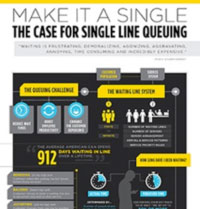
Vol. XIII, No. 1, January 2013
- Editor's corner
- The challenges of producing international entertainment projects: Our Vietnam experience
- The science of the queue
- Foundations Entertainment University goes to Vegas
- Feasibility and economics for entertainment projects in emerging economies
- Birthday University scholarships
- Location-based entertainment experiences go premium
- Entertainment spending in the local community by income
The science of the queue

Location-based leisure businesses, including entertainment centers, theme parks, zoos, aquariums, cultural institutions and restaurants, often end up with customer lines. It could be a line waiting for a ride, to checkout from a redemption or gift shop, to order food at a fast food or fast casual restaurant or to pay at the cashier. Regardless, no one likes to wait in a line. If the wait seems too long, customers will often bail out and abandon what they were waiting to do or buy, resulting in a negative impact on both the business’ reputation and profit. Due to the importance of not having customers wait too long in lines, the dynamics of customer line waits and queue design has received a lot of research.
Envirosell, an international retail consultancy, has timed retail shoppers in line to determine how real wait times compared with how long shoppers felt they had waited. Up to about two to three minutes, the perception of the wait "was very accurate," says Paco Underhill, Envirosell's founding president. However, after three minutes, the perceived wait time seems longer than it actually was with each passing minute. "So if the person was actually waiting four minutes, the person said 'I've been waiting five or six minutes.' If they got to five minutes, they would say 'I've been waiting 10 minutes," Mr. Underhill says.
Men are more likely to give up and abandon a line than women. Men start to inflate the perceived time after only two minutes versus three for women.
Dr. Janakiraman, assistant professor of marketing at Eller College of Management at the University of Arizona, is the lead author of a recently published research paper on how impatient shoppers get in lines. Dr. Janakiraman concluded shoppers are likely to abandon a line that might take between one and 10 minutes longer to get through after the first two or three minutes if they feel it isn't moving fast enough for them.
There is a simple formula to determine the expected average wait time in a line. Take the number of people already in the line and divide it by the number of people entering the line per minute to determine the average number of minutes of wait time.
The most efficient design of lines when there is more than one cashier or transaction point is counterintuitive. A single-file line leading to three cashiers is about three times faster than having a separate line for each cashier. The reason is that at least one line could be held up some random event like the customer’s credit card not working, the price missing from an item, or the customer getting in a long conversation with the cashier, what is called a line stopper. With a single line, the line stopper will only hold up one register while the line will continue to keep moving through the other two.
For more about line design, Lavi Industries has a queue management guide titled The Art and Science of Queuing that you can download as a PDF by clicking here.
Vol. XIII, No. 1, January 2013
- Editor's corner
- The challenges of producing international entertainment projects: Our Vietnam experience
- The science of the queue
- Foundations Entertainment University goes to Vegas
- Feasibility and economics for entertainment projects in emerging economies
- Birthday University scholarships
- Location-based entertainment experiences go premium
- Entertainment spending in the local community by income


 Click to view in full size
Click to view in full size